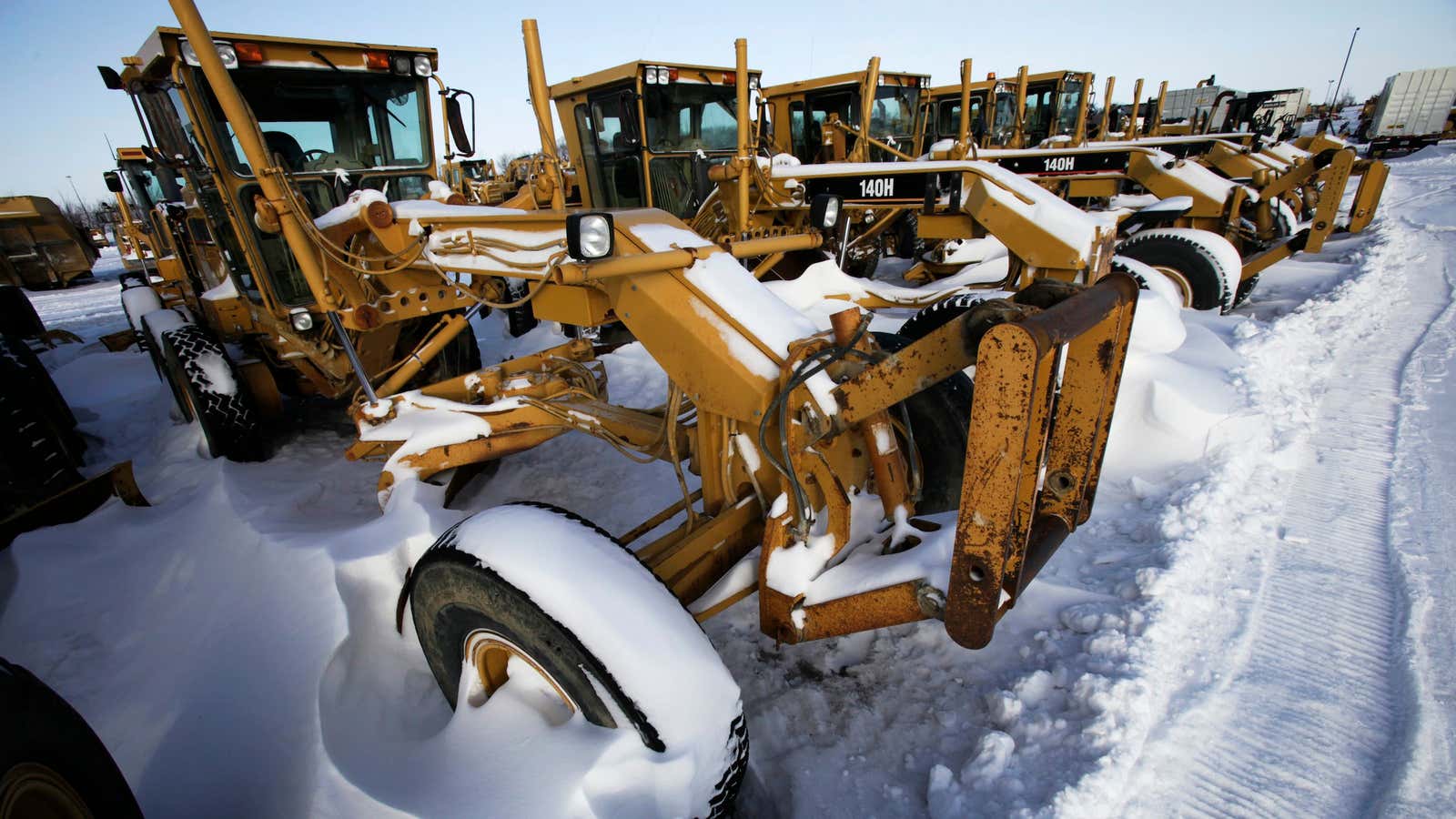Caterpillar is expected sell nearly $70 billion worth of machines for construction, mining and energy this year, everything from log skidders to tunnel borers. The US company essentially makes the stuff that makes economies grow; but how much of that stuff they need depends on how fast they expect to grow. So what worries Caterpillar is a good measure of what should worry the world.
CEO Doug Oberhelman’s team expects continued weak growth in 2013, but he told investors (registration required) on Sept. 24 that the company is prepared to manage an unpredictable economic situation. The company has prepared scenarios for a mild recession by forecasting a 15% cut in sales, and for a “world-wide type recession”—something it’s seen only twice since 1946—by estimating a 25% drop in sales. Its earnings-per-share estimates in each scenario ($8-10 expected, $6 in a mild recession, $3.50 in a crisis) are based on its expectations of how political decisions all around the world will affect growth. Here’s what the company is watching.
Central Banks on the march. Oberhelman attracted some attention when he commented on the slumping global growth that has dinged his company’s stock price 5% on the year.
“We think that the reason that we hit the soft spot in mid-2012 was because the feds were too restrictive a year ago,” he told an audience of analysts. “And sure enough the economy slowed a little bit this summer again, now it’s full-out accommodation.”
Caterpillar’s best-case scenario expects coordinated easing from central banks around the world to continue their recent trend of pro-growth policies.
Foreign exchange risk. Central banks affect growth, but they also affect exchange rates. In the second quarter of 2012, Caterpillar lost $1 billion, 5.75% of sales and revenues, moving money from foreign currencies into the US dollar. While it sites foreign manufacturing facilities so as to limit currency risk, further depreciation of the dollar against emerging market currencies will bolster the company’s fortunes.
The “fiscal cliff.” America’s automatic tax increases and spending cuts that are due to take effect in January aren’t going to happen, Oberhelman says. After three days talking to politicians in Washington (“I couldn’t wait to get home!”) he was convinced that they would reach a deal, regardless of the outcome of November’s federal elections, to avoid the 3% decline in the US economy forecast if the plan goes into effect. The company’s best-case scenario depends on the truth of these assurances.
The European financial crisis. Caterpillar expects the powers that be in Europe to “do the minimum”—a fairly accurate description of their actions so far. Caterpillar’s European business is “already in a trough,” Oberhelman says, but the ability of the EU to contain the region’s problems could be the difference between modest growth and downturn around the world.
Brazil’s infrastructure plans. The company has high hopes for Brazil, which it expects to come out of its brief slump; no doubt Caterpillar is pleased with President Dilma Roussef’s $66 billion infrastructure building plan. Failure to follow through on those plans could spell trouble.
China’s stimulus moves. “I expect a year from now we’ll see recovery in China,” Oberhelman says, crediting policymakers there for stimulus efforts. One example is Sichuan province’s plan to spend $582 billion on infrastructure; some of that will surely end up in Caterpillar’s pockets, but if China pessimists are right about the country’s long-term weaknesses, the company will be in a tough spot.
Will the US rebound ever come? Caterpillar hasn’t had anything to do with the US housing market since 2006, Olberhelman says, but the company expects an expanding population will inevitably create demand for new construction. That prospect depends on US policymakers taking measures to bolster the housing market, which haven’t paid off yet despite high hopes.
The global middle class. Ultimately, the company is pinning its hopes on population growth and the emerging global middle class creating demand for new infrastructure, homes, energy and commodities. But as workers from the China to the US are learning, it’s very hard to maintain a consumer class economy, much less create one.
